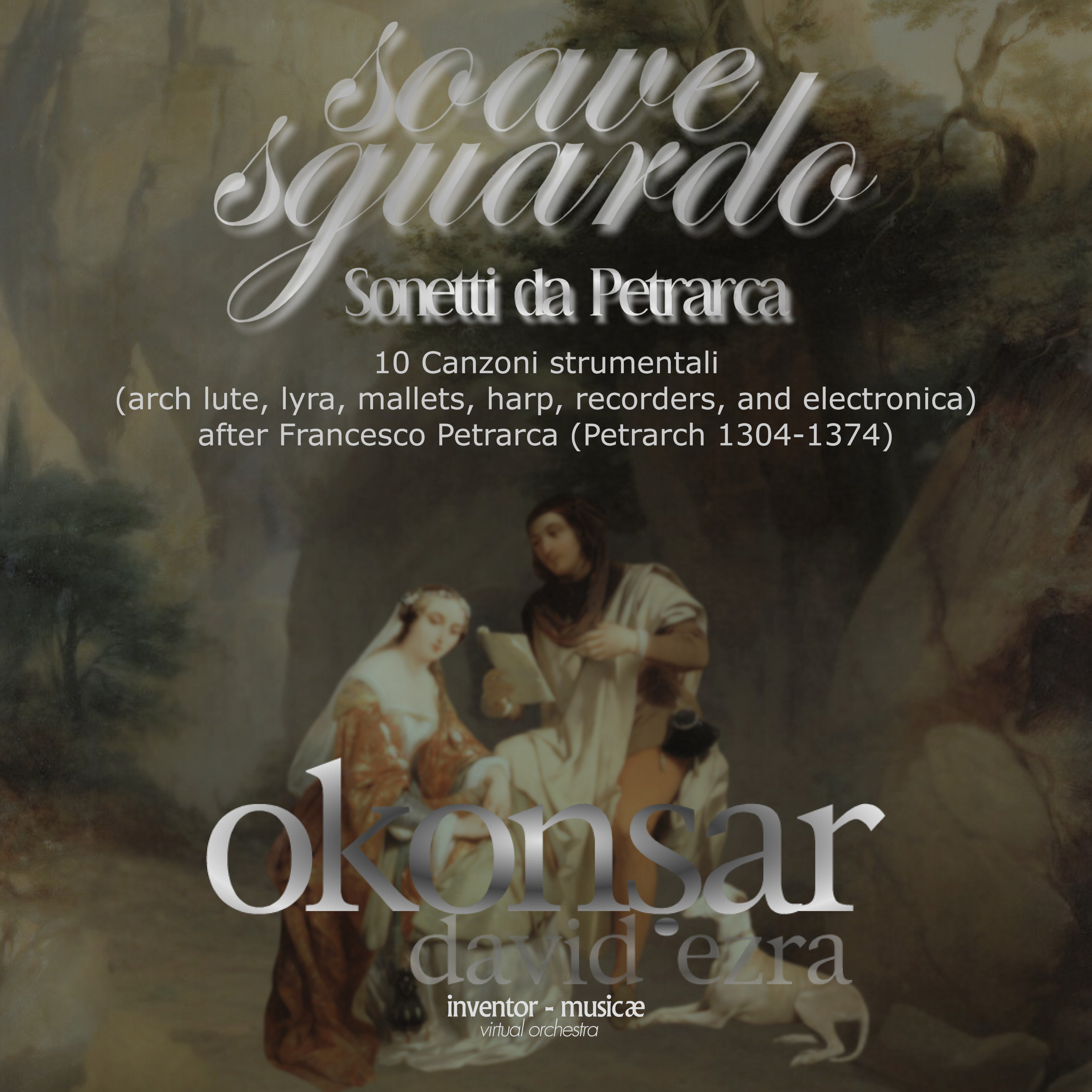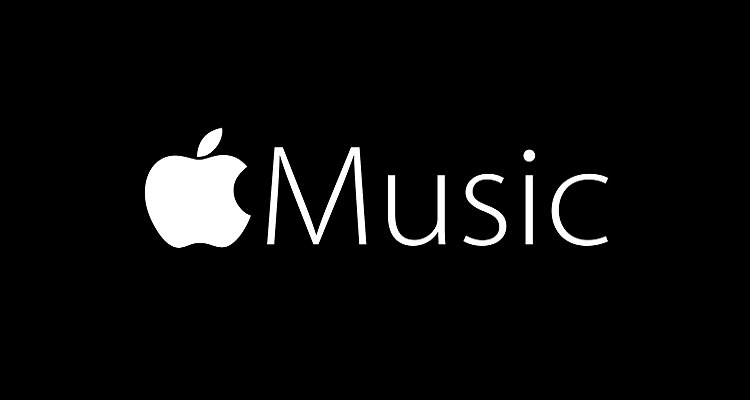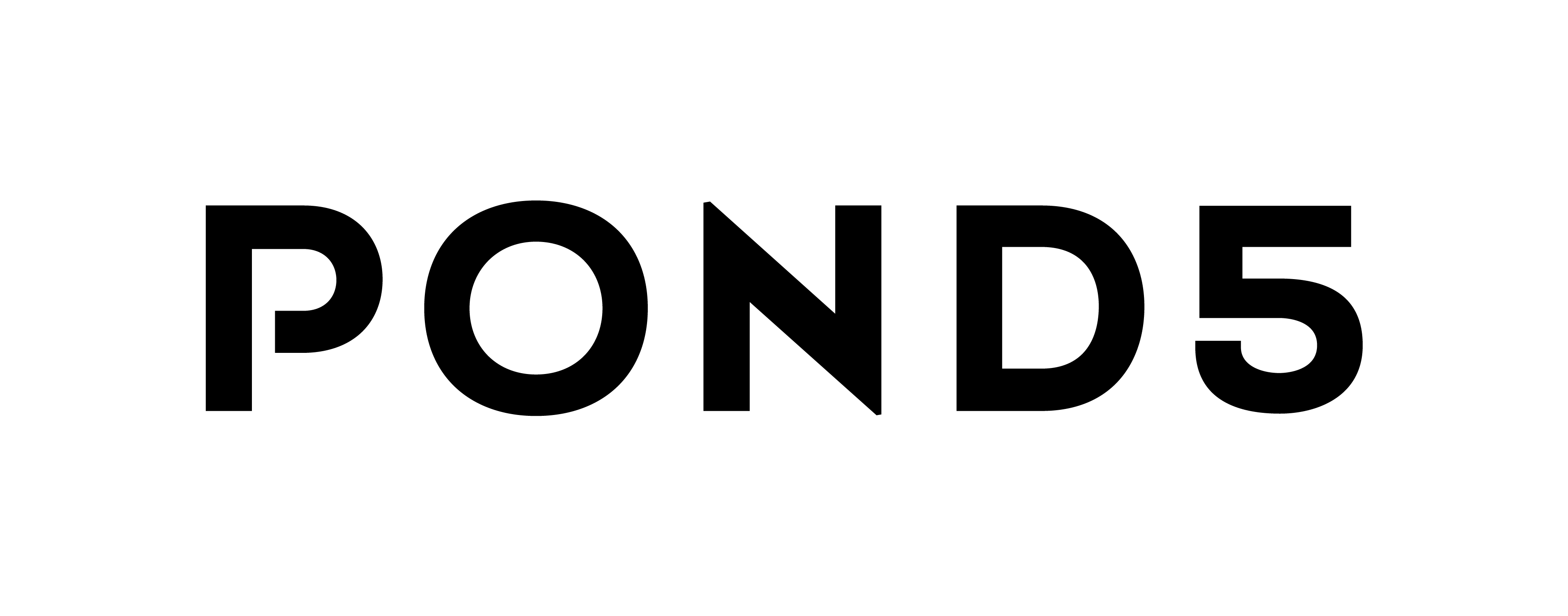
Downloads only. Physical CD not available.
|
Soave Sguardo
(Gentle Gaze)
10 Canzoni strumentali for arch lute, lyra, mallets, harp, recorders, and electronica after Francesco Petrarca (Petrarch 1304-1374) Soave Sguardo – Sonetti da Petrarca is David Ezra Okonsar's latest endeavor, a luminous synthesis of Renaissance sound and modern artistry. Built on the poetic foundations of Francesco Petrarca's fourteenth-century sonnets, this project interlaces the warm resonance of historical instruments with the immersive possibilities of contemporary electronic music. The journey bridges centuries, echoing the enduring power of Petrarch's reflections on love, longing, and devotion. Key to Soave Sguardo are the instruments that shape its singular timbre. The arch lute infuses each piece with gentle, plucked chords evocative of medieval courtyards and hushed audiences. Its distinctive extended neck and deep body offer a tactile link to an earlier age, providing a bed of subtle harmonies that complement Petrarca's verses. In contrast, the Lyra introduces a bowed texture whose sustained lines imbue the music with an almost vocal, sometimes lamenting, sometimes exultant, yet always charged with emotion. Throughout the album, mallets act as a shimmering accent. Their bright or mellow tones punctuate the ensemble's interplay, offering both rhythmic punctuation and a touch of contemporary sparkle. Even a brief run on a marimba-like instrument or a chiming glockenspiel can transport listeners from archaic settings to modern cinematic landscapes. Meanwhile, the harp adds a further dimension of regal beauty: shimmering arpeggios conjure visions of pastoral scenes and romantic tableaux, while more intricate passages merge seamlessly with the arch lute, weaving a luminous, multilayered tapestry. The timeless character of the recorders helps anchor Soave Sguardo in its historical roots. Their pure, flute-like tone recalls rustic gatherings, formal courts, and the simpler pleasures of an earlier world. Yet, Okonsar enlivens these lines with nuanced phrasing that integrates gracefully with the project's modern core. In fact, the gentle blending of the recorders' antique warmth with the broader palette sets the stage for the album's most striking aspect: the infusion of electronica. For David Ezra Okonsar, electronic music is no mere add-on but rather a driving force that complements Renaissance timbres. Soft drones, pulsing synthesizer lines, and carefully sculpted digital textures expand the expressive scope of each sonnet's musical setting. Sometimes, these electronics hover discreetly, allowing the arch lute and recorders to shine. At other moments, they envelop the acoustic instruments in a wash of color or rhythm that gently propels the listener forward, underscoring the timeless human emotions that Petrarch's lines evoke. This seamless fusion echoes themes found in Okonsar's earlier works. In his Symphony N.6 (Pastorale), he wedded classical structures to soaring Latin vocals, while in Baroque Horizons, he juxtaposed harpsichord and orchestra with modern synthesizers. Likewise, Momotaro brought Japanese folk narratives to life through a chamber ensemble. These projects reveal Okonsar's passion for bridging disparate musical and cultural worlds. With Soave Sguardo, that vision reaches a new apex, blending era-spanning instruments in service to Petrarch's delicate yet profound writings. The sonnets of Petrarch explore themes of love, virtue, and yearning ideas that resonate across centuries. Soave Sguardo seeks to capture this universality by placing these verses in a dynamic, shape-shifting soundscape. The synergy of the arch lute's eloquent phrases, the Lyra's plaintive lines, the harp's shimmering elegance, the recorder's pastoral charm, and the vibrant energy of mallets finds further depth in electronic motifs that expand beyond the boundaries of classical Renaissance performance. Okonsar's meticulous approach ensures that no single element dominates; instead, each voice engages in an ongoing conversation. In some passages, the electronics provide a subtle undercurrent, suggesting the heart's rhythmic pulse or a fleeting memory. In others, the acoustic instruments gently recede, allowing resonant drones or swirling digital effects to bathe the soundspace in mystery. These contrasts mirror Petrarch's sonnets' complexities, where devotion, doubt, ecstasy, and sorrow intertwine. Ultimately, Soave Sguardo – Sonetti da Petrarca exemplifies David Ezra Okonsar's commitment to revitalizing historical art forms through contemporary expression. He honors Petrarch's timeless poetic themes by merging Renaissance instruments and cutting-edge electronics and reaffirms music's limitless capacity to transform and illuminate. The result is both an homage to the past and a testament to how beauty can transcend epochs when imagination finds room to grow. < click for detailed movements and poems >
-------------------------------------------------- FR Soave Sguardo – Sonetti da Petrarca est la dernière création de David Ezra Okonsar, une synthèse lumineuse du son de la Renaissance et de l'art moderne. Construit sur les fondations poétiques des sonnets du XIVe siècle de Francesco Petrarca, ce projet entrelace la résonance chaleureuse des instruments historiques avec les possibilités immersives de la musique électronique contemporaine. Le voyage traverse les siècles, faisant écho à la puissance durable des réflexions de Pétrarque sur l'amour, le désir et la dévotion. La clé de Soave Sguardo réside dans les instruments qui façonnent son timbre singulier. Le luth imprègne chaque pièce d'accords doux et pincés évoquant les cours médiévales et les publics silencieux. Son manche allongé et son corps profond distinctifs offrent un lien tactile avec une époque antérieure, offrant un lit d'harmonies subtiles qui complètent les vers de Pétrarque. En revanche, la lyre introduit une texture à l'archet dont les lignes soutenues imprègnent la musique d'un son presque vocal, parfois plaintif, parfois exultant, mais toujours chargé d'émotion. Tout au long de l'album, les maillets agissent comme un accent chatoyant. Leurs tons vifs ou doux ponctuent l'interaction de l'ensemble, offrant à la fois une ponctuation rythmique et une touche d'éclat contemporain. Même un bref passage sur un instrument de type marimba ou un glockenspiel carillonnant peut transporter les auditeurs de décors archaïques à des paysages cinématographiques modernes. Pendant ce temps, la harpe ajoute une autre dimension de beauté royale : des arpèges chatoyants évoquent des visions de scènes pastorales et de tableaux romantiques, tandis que des passages plus complexes se fondent harmonieusement avec le luth, tissant une tapisserie lumineuse à plusieurs niveaux. Le caractère intemporel des flûtes à bec contribue à ancrer Soave Sguardo dans ses racines historiques. Leur son pur, semblable à celui d'une flûte, rappelle les rassemblements rustiques, les cours formelles et les plaisirs plus simples d'un monde antérieur. Pourtant, Okonsar anime ces lignes avec un phrasé nuancé qui s'intègre gracieusement au cœur moderne du projet. En fait, le doux mélange de la chaleur antique des flûtes à bec avec la palette plus large prépare le terrain pour l'aspect le plus frappant de l'album : l'infusion d'électronique. Pour David Ezra Okonsar, la musique électronique n'est pas un simple ajout mais plutôt une force motrice qui complète les timbres de la Renaissance. Des drones doux, des lignes de synthétiseur pulsées et des textures numériques soigneusement sculptées élargissent la portée expressive du cadre musical de chaque sonnet. Parfois, ces éléments électroniques planent discrètement, permettant au luth et aux flûtes à bec de briller. À d'autres moments, ils enveloppent les instruments acoustiques d'un flot de couleurs ou de rythmes qui propulse doucement l'auditeur vers l'avant, soulignant les émotions humaines intemporelles que les lignes de Pétrarque évoquent. Cette fusion harmonieuse fait écho aux thèmes que l'on retrouve dans les œuvres antérieures d'Okonsar. Dans sa Symphonie n°6 (Pastorale), il a marié des structures classiques à des chants latins envolés, tandis que dans Baroque Horizons, il a juxtaposé le clavecin et l'orchestre à des synthétiseurs modernes. De même, Momotaro a donné vie à des récits folkloriques japonais à travers un ensemble de chambre. Ces projets révèlent la passion d'Okonsar pour la création de ponts entre des mondes musicaux et culturels disparates. Avec Soave Sguardo, cette vision atteint un nouveau sommet, en mélangeant des instruments de différentes époques au service des écrits délicats mais profonds de Pétrarque. Les sonnets de Pétrarque explorent des thèmes d'amour, de vertu et d'idées nostalgiques qui résonnent à travers les siècles. Soave Sguardo cherche à capturer cette universalité en plaçant ces versets dans un paysage sonore dynamique et changeant de forme. La synergie des phrases éloquentes de l'archuth, des lignes plaintives de la lyre, de l'élégance chatoyante de la harpe, du charme pastoral de la flûte à bec et de l'énergie vibrante des maillets trouve une profondeur supplémentaire dans les motifs électroniques qui s'étendent au-delà des limites de l'interprétation classique de la Renaissance. L'approche méticuleuse d'Okonsar garantit qu'aucun élément ne domine ; au contraire, chaque voix s'engage dans une conversation continue. Dans certains passages, l'électronique fournit un courant sous-jacent subtil, suggérant le pouls rythmique du cœur ou un souvenir fugace. Dans d'autres, les instruments acoustiques s'éloignent doucement, permettant à des drones résonnants ou à des effets numériques tourbillonnants de baigner l'espace sonore dans le mystère. Ces contrastes reflètent la complexité des sonnets de Pétrarque, où la dévotion, le doute, l'extase et le chagrin s'entremêlent. En fin de compte, Soave Sguardo – Sonetti da Petrarca illustre l'engagement de David Ezra Okonsar à revitaliser les formes d'art historiques à travers l'expression contemporaine. Il rend hommage aux thèmes poétiques intemporels de Pétrarque en fusionnant instruments de la Renaissance et électronique de pointe et réaffirme la capacité illimitée de la musique à transformer et à illuminer. Le résultat est à la fois un hommage au passé et un témoignage de la façon dont la beauté peut transcender les époques lorsque l'imagination trouve de l'espace pour se développer. -------------------------------------------------- TR Soave Sguardo – Sonetti da Petrarca, David Ezra Okonsar'ın son albümü, Rönesans tınıları ve modern müziğin özgün bir sentezidir. Francesco Petrarca'nın on dördüncü yüzyıl sonelerinin şiirsel temelleri üzerine inşa edilen bu proje, tarihi enstrümanların sıcak yankısını çağdaş elektronik müziğin sürükleyici olanaklarıyla iç içe geçiriyor. Yolculuk, Petrarch'ın aşk, özlem ve bağlılık üzerine düşüncelerinin kalıcı gücünü yansıtarak yüzyılları birbirine bağlıyor. Soave Sguardo'nun anahtarı, onun eşsiz tınısını şekillendiren enstrümanlardır. Lavta, her parçaya ortaçağ mekanlarını ve dönemin ozanlarını çağrıştıran nazik, koparılmış akorlar aşılar. Kendine özgü uzatılmış sapı ve derin gövdesiyle bu çalgı, Petrarca'nın dizelerini tamamlayan ince armonilerden oluşan bir alt yapı sağlayarak geçmiş bir çağa dokunsal bir bağlantı sunar. Buna karşılık, Lyra, müziğe neredeyse vokal, bazen ağıt yakan, bazen coşkulu ama her zaman duygu yüklü bir şekilde dokunan yaylı bir doku sunar. Albüm boyunca, vurmalı çalgılar olan Marimba, Vibrafon, Ksilofon net ve parlak bir vurgu görevi görür. Parlak veya yumuşak tonlarıyla, topluluğun etkileşimini vurgular ve hem ritmik noktalama hem de çağdaş bir ışıltı dokunuşu sunar. Marimba benzeri bir enstrüman ama kristal gibi çınlayan bir Glockenspiel üzerinde kısa bir çalışma bile dinleyicileri arkaik ortamlardan modern sinematik manzaralara taşıyabilir. Bu arada, Arp daha da görkemli bir güzellik boyutu ekler: derin arpejler pastoral sahnelerin ve romantik tabloların vizyonlarını çağrıştırırken, daha karmaşık pasajlar Lavtayla kusursuz bir şekilde birleşerek aydınlık, çok katmanlı bir doku örer. Blok flütlerin ölümsüz tınıları, Soave Sguardo'nun tarihi köklerine dayanmasına yardımcı olur. Saf, flüt benzeri tonları, rustik çağrışımları, arkaik çağların ve daha önceki bir dünyanın doğal ve naif zevklerini anımsatıyor. Yine de, Okonsar bu ezgileri projenin modern çekirdeğiyle zarif bir şekilde bütünleşen nüanslı ifadelerle canlandırıyor. Aslında, blok flütlerin antik sıcaklığının daha geniş paletle nazikçe harmanlanması, albümün en çarpıcı yönü için sahneyi hazırlıyor: bu da elektronikanın (günümüz elektronik müzik çalgıları, sentetizörler) infüzyonu. David Ezra Okonsar için elektronik müzik, bu kapsamda, sadece bir eklenti değil, Rönesans tınılarını tamamlayan bir itici güçtür. Yumuşak dronlar, nabız gibi atan sentetizör çizgileri ve dikkatlice şekillendirilmiş dijital dokular, her sonenin müzikal ortamının ifade kapsamını genişletir. Bazen, bu elektronikler gizlice süzülür ve lavta ve blok flütlerin parlamasına izin verir. Diğer anlarda, akustik enstrümanları, dinleyiciyi nazikçe ileriye doğru iten bir renk veya ritim dalgasıyla sarar ve Petrarch'ın satırlarının uyandırdığı ebedi ve insani duyguları vurgular. Bu kusursuz füzyon, Okonsar'ın önceki çalışmalarında bulunan temaları yankılar. 6. Senfonisinde (Pastorale), klasik yapıları yükselen Latin vokalleriyle birleştirirken, Barok Ufuklar'da (11. Senfoni) klavsen ve orkestrayı modern sentezleyicilerle bir araya getirdi. Aynı şekilde, Momotaro (Japon halk masalları) da bir oda topluluğu aracılığıyla Japon halk anlatılarını hayata geçirdi. Bu projeler, Okonsar'ın farklı müzik ve kültür dünyaları arasında köprü kurma tutkusunu ortaya koyuyor. Soave Sguardo ile bu vizyon, Petrarch'ın narin ama derin yazılarının hizmetinde çağlar boyunca uzanan enstrümanları harmanlayarak yeni bir zirveye ulaşıyor. Petrarch'ın soneleri, yüzyıllar boyunca yankılanan aşk, erdem ve özlem fikirlerinin temalarını araştırıyor. Soave Sguardo, bu dizeleri dinamik, şekil değiştiren bir ses manzarasına yerleştirerek bu evrenselliği yakalamaya çalışıyor. Lavtanın etkileyici ifadelerinin, Lyra'nın hüzünlü dizelerinin, arpın ışıltılı zarafetinin, flütün pastoral cazibesinin ve klavyeli vurma çalgıların canlı enerjisinin sinerjisi, klasik Rönesans performansının sınırlarının ötesine uzanan elektronik motiflerde daha fazla derinlik bulur. Okonsar'ın titiz yaklaşımı, hiçbir tek öğenin baskın olmamasını sağlar; bunun yerine, her ses devam eden bir sohbete katılır. Bazı pasajlarda, elektronikler kalbin ritmik nabzını veya geçici bir anıyı ima eden ince bir alt akım sağlar. Diğerlerinde, akustik enstrümanlar yavaşça geri çekilir ve yankılanan uğultulara veya dönen dijital efektlere ses alanını gizemle yıkamasına izin verir. Bu karşıtlıklar, bağlılığın, şüphenin, coşkunun ve hüznün iç içe geçtiği Petrarch'ın sonelerinin karmaşıklıklarını yansıtır. Sonuç olarak, Soave Sguardo – Sonetti da Petrarca, David Ezra Okonsar'ın çağdaş ifade yoluyla tarihi sanat biçimlerini canlandırma taahhüdünü örneklemektedir. Rönesans enstrümanlarını ve son teknoloji elektronikleri birleştirerek Petrarch'ın zamansız şiirsel temalarına saygı gösteriyor ve müziğin sınırsız dönüştürme ve aydınlatma kapasitesini yeniden teyit ediyor. Sonuç hem geçmişe bir saygı duruşu hem de hayal gücü büyümek için yer bulduğunda güzelliğin çağları nasıl aşabileceğinin bir kanıtı. 1. Sonnet 1 "Voi ch'ascoltate in rime sparse il suono" (Canzoniere, Sonetto I, c. 1336–1374) "You Who Hear the Sound in Scattered Rhymes" Petrarch's introductory poem, where he acknowledges his readers and expresses regret and humility about his youthful love and its resultant sorrow. Voi ch'ascoltate in rime sparse il suono di quei sospiri ond'io nudriva 'l core. You who hear in scattered rhymes the sound of those sighs on which I once fed my heart. 2. Sonnet 3 "Era il giorno ch'al sol si scoloraro" (Canzoniere, Sonetto III, c. 1336–1374) "It Was the Day When the Sun's Rays Were Darkened" Petrarch marks the exact day (Good Friday) he first saw Laura, underscoring the sacred and fateful nature of that encounter. Era il giorno ch'al sol si scoloraro le fronde. It was the day the sun's rays lost their color upon the leaves. 3. Sonnet 61 "Benedetto sia 'l giorno, e 'l mese, e l'anno" (Canzoniere, Sonetto LXI, c. 1336–1374) "Blessed Be the Day, the Month, the Year" A joyful outpouring of gratitude for the moment and circumstances that led him to behold Laura; it's celebratory despite the heartache. Benedetto sia 'l giorno, e 'l mese, e l'anno, e la stagione, e 'l tempo, e l'ora, e 'l punto. Blessed be the day, the month, and the year, and the season, and the time, and the hour, and the moment. 4. Sonnet 90 "Erano i capei d'oro a l'aura sparsi" (Canzoniere, Sonetto XC, c. 1336–1374) "Her Golden Hair Was Loosened in the Breeze" One of Petrarch's most famous depictions of Laura's beauty, recalling her golden hair and the profound impact it had on him. Erano i capei d'oro a l'aura sparsi, che 'l mio cor facean si dolce guerra. Her golden hair was scattered to the breeze, waging such a sweet war upon my heart. 5. Sonnet 132 "S'amor non è, che dunque è quel ch'io sento?" (Canzoniere, Sonetto CXXXII, c. 1336–1374) "If This Is Not Love, Then What Do I Feel?" Petrarch wrestles with the nature of his passion, pondering the paradox and confusion of the emotions that consume him. S'amor non è, che dunque è quel ch'io sento? Ma s'egli è amor, perdio, che cosa e quale? If this is not love, then what is it I feel? But if it is love, by God, what is it, and of what kind? 6. Sonnet 134 "Pace non trovo, e non ho da far guerra" (Canzoniere, Sonetto CXXXIV, c. 1336–1374) "I Find No Peace, Yet I Make No War" One of Petrarch's most famous laments, riddled with contradictions that reflect his tormented state-he is trapped between love's pleasure and pain. Pace non trovo, e non ho da far guerra; e temo e spero, ed ardo e son un ghiaccio. I find no peace, and yet I wage no war; I fear and hope, I burn and I am ice. 7. Sonnet 164 "I' vidi in terra angelici costumi" (Canzoniere, Sonetto CLXIV, c. 1336–1374) "I Saw on Earth Angelic Virtues" Petrarch perceives Laura's beauty as transcendent, angelic, hinting at something divine beyond merely human allure. I' vidi in terra angelici costumi e celesti bellezze al mondo sole. I saw on earth angelic virtues and heavenly beauties unique in this world. 8. Sonnet 189 "Passa la nave mia colma d'oblio" (Canzoniere, Sonetto CLXXXIX, c. 1336–1374) "My Ship, Laden with Oblivion, Sails On" Using a seafaring metaphor, Petrarch depicts love as a ship navigating treacherous waters at night, reflecting his emotional upheaval. Passa la nave mia colma d'oblio per aspro mare, a mezza notte, il verno. My ship, laden with oblivion, passes through harsh seas, at midnight, in winter. 9. Sonnet 267 "Oimè il bel viso, oimè il soave sguardo" (Canzoniere, Sonetto CCLXVII, c. 1336–1374) "Alas, the Beautiful Face, Alas, the Gentle Gaze" Composed after Laura's death, this is a lament for her physical presence-her face, her glance, her regal bearing-now lost forever. Oimè il bel viso, oimè il soave sguardo, oimè il leggiadro portamento altero! Alas, the beautiful face, alas, the gentle gaze, alas, the graceful yet proud bearing! 10. Sonnet 302 "Levommi il mio pensier in parte ov'era" (Canzoniere, Sonetto CCCII, c. 1336–1374) "My Thought Carried Me to Where She Was" Petrarch's mind ascends to the place he imagines Laura's soul now resides (Heaven). It mingles earthly longing with a spiritual, transcendent vision of love. Levommi il mio pensier in parte ov'era quella ch'io cerco, la qual ora non è. My thought lifted me to the place where she was- she whom I seek, who is no longer here. |
||||||||||||||||||||||||
| |
||||||||||||||||||||||||
|
||||||||||||||||||||||||





